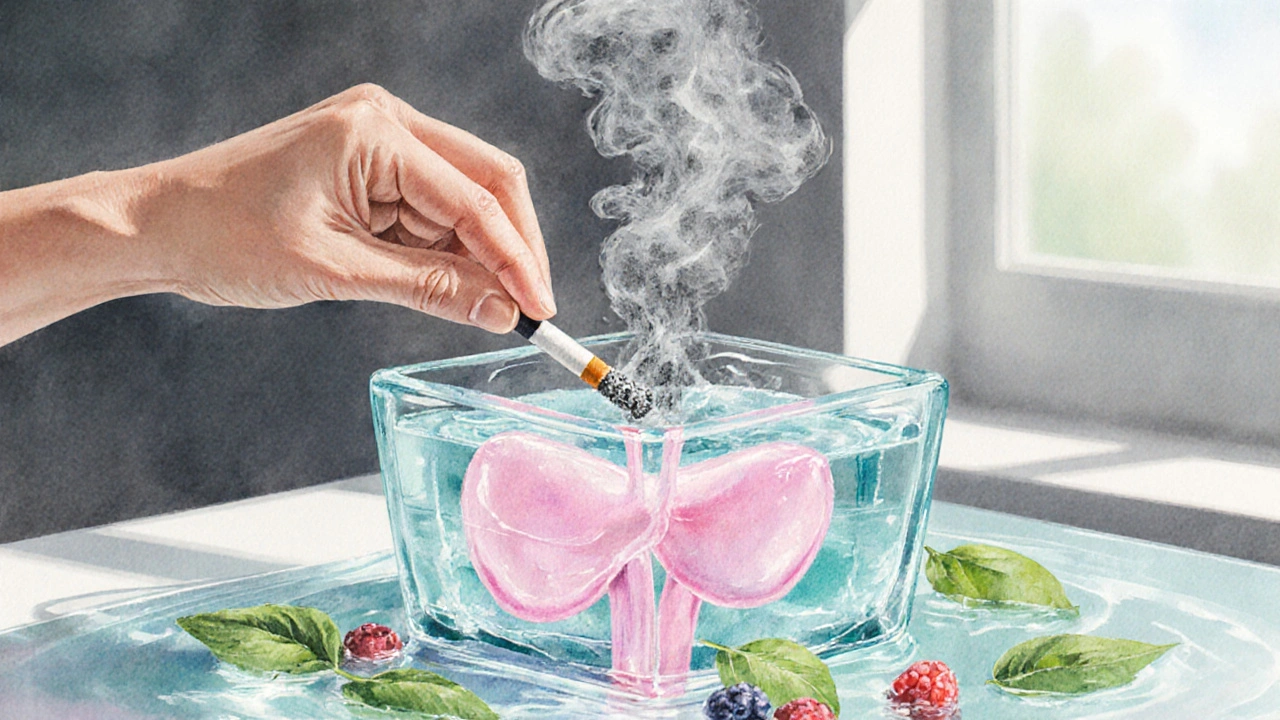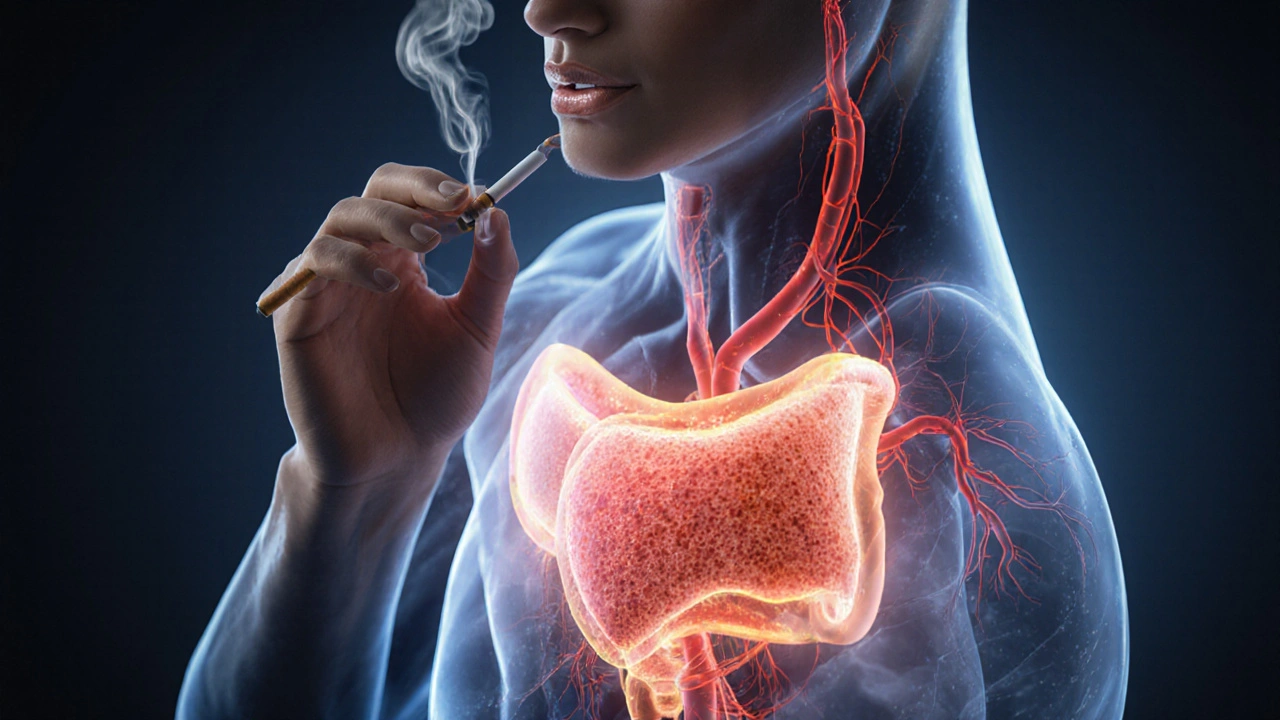Bladder Pain Risk Calculator
Your Smoking Profile
Answer the following questions to estimate your risk of bladder pain.
Your Bladder Pain Risk Assessment
When you light up a cigarette, the damage isn’t limited to your lungs. Smoking is a habit of inhaling combusted tobacco that delivers nicotine and a cocktail of toxins to the body. Those chemicals travel through the bloodstream and eventually reach the bladder, where they can irritate the lining, trigger inflammation, and amplify pain signals. If you’ve ever felt a burning urge to pee after a cigarette, you’ve experienced the direct link between bladder pain and tobacco use. This article breaks down why smoking fuels bladder discomfort, what happens when you quit, and practical steps to ease the transition.
How Smoking Triggers Bladder Pain
Every puff releases over 7,000 chemicals, including nicotine, tar, formaldehyde, and heavy metals. Once absorbed, these substances bind to receptors in the urinary tract. Nicotine acts as a vasoconstrictor, narrowing blood vessels that supply the bladder wall. Reduced blood flow means the tissue gets less oxygen and fewer nutrients, making it more vulnerable to irritation.
At the same time, carcinogens such as 4-aminobiphenyl directly damage the bladder’s urothelium-the thin protective lining. Microscopic lesions develop, and the body’s immune response releases inflammatory mediators like prostaglandins and cytokines. The result? A hypersensitive bladder that reacts painfully to even normal urine volumes.
Research from the European Urology Association (2023) shows that smokers are 2.5 times more likely to report chronic pelvic pain compared to non‑smokers. The study monitored 4,500 adults over five years and found a clear dose‑response: the more cigarettes per day, the higher the reported pain score.
Symptoms That Often Overlap With Smoking‑Related Issues
Bladder pain isn’t the only urinary symptom smokers face. Common complaints include:
- Frequent urge to urinate, especially at night (nocturia)
- Burning sensation during urination
- Blood in the urine (hematuria), which can signal early bladder cancer
- Reduced bladder capacity, leading to over‑full feeling
These signs can also appear in urinary tract infection (UTI) or chronic cystitis. The overlap often confuses patients and clinicians, delaying proper treatment. If you notice any of these symptoms, a urine analysis and cystoscopy are the gold standards for ruling out infection, stones, or early bladder cancer.
What Happens Inside Your Body When You Quit
The moment you stop smoking, the body begins a healing cascade. Within 48 hours, carbon monoxide levels drop, and oxygen delivery improves. Nicotine withdrawal causes a temporary spike in stress hormones, which can actually heighten bladder sensitivity for a week or two. However, after about four weeks, the bladder’s blood supply normalizes, and inflammatory markers begin to fall.
A 2022 longitudinal study of 1,200 ex‑smokers reported a 30% reduction in reported bladder pain after six months of abstinence. Those who combined quitting with a healthy diet rich in antioxidants (berries, leafy greens) saw an even greater improvement-up to 45% less pain after one year.
Detoxifying the bladder also involves flushing out trapped metabolites. Drinking at least eight glasses of water daily helps dilute urine, reducing the concentration of irritants that cling to the urothelium. Adding cranberry juice (unsweetened) can provide pro‑anthocyanidins that further protect the bladder lining.

Practical Steps to Stop Smoking and Relieve Bladder Discomfort
- Set a quit date. Mark it on your calendar and tell a friend or family member for accountability.
- Choose a quitting aid. Nicotine replacement therapy (patches, gum) or prescription meds like varenicline have proven success rates of 30‑35% when paired with counseling.
- Enroll in a quit smoking program. Many NHS services offer free group sessions and phone helplines.
- Replace the habit. Chew sugar‑free gum, keep hands busy with a stress ball, or practice deep‑breathing exercises when cravings hit.
- Boost bladder health. Increase fluid intake, limit caffeine and alcohol (both bladder irritants), and incorporate pelvic floor exercises to strengthen bladder control.
- Track progress. Use a journal or a mobile app to log cravings, pain levels, and urine frequency. Seeing trends can motivate you to stay smoke‑free.
Most importantly, be patient. The urinary system can take weeks to fully recover, but every cigarette avoided speeds up the repair process.
Risk Reduction and Lifestyle Tips After Quitting
Even after you’ve quit, maintaining bladder health requires ongoing attention. Here are evidence‑based habits that keep pain at bay:
- Hydration. Aim for 2‑3 liters of water daily. It dilutes urine and promotes regular emptying, preventing toxin buildup.
- Balanced diet. Foods rich in omega‑3 fatty acids (salmon, flaxseed) have anti‑inflammatory properties that soothe the bladder wall.
- Avoid bladder irritants. Reduce intake of spicy foods, citrus, and artificial sweeteners, all of which can trigger urgency.
- Regular physical activity. Walking, swimming, or yoga improve circulation, aiding the bladder’s healing process.
- Routine check‑ups. Annual urine tests and, for high‑risk individuals (age>50, family history of cancer), a cystoscopy can catch early changes before they become serious.
Combining these lifestyle choices with a smoke‑free life not only lowers the chance of recurring bladder pain but also cuts the risk of bladder cancer by up to 50% according to the National Cancer Institute (2024).
Comparison: Bladder Pain Metrics - Smokers vs. Non‑Smokers
| Metric | Current Smokers | Former Smokers (≥6months quit) | Never Smokers |
|---|---|---|---|
| Reported chronic bladder pain (%) | 28 | 12 | 7 |
| Average pain score (0‑10) | 5.6 | 3.2 | 2.1 |
| Frequency of nocturia (≥2 times/night) | 42 | 25 | 18 |
| Incidence of hematuria (%) | 9 | 4 | 2 |
Frequently Asked Questions
Can quitting smoking eliminate bladder pain completely?
Most people see a significant drop in pain within months, but complete elimination depends on other factors like existing bladder conditions, diet, and hydration. Ongoing bladder care is still essential.
Is there a safe level of smoking that won’t affect my bladder?
No. Even low‑volume smoking (1‑2 cigarettes a day) introduces toxins that can irritate the bladder. Risk scales with the number of cigarettes, but any exposure is harmful.
Do nicotine patches also affect bladder health?
Nicotine patches deliver nicotine without the harmful combustion by‑products, so they are far less likely to trigger bladder inflammation. However, the vasoconstrictive effect of nicotine remains, so some users may notice mild symptoms initially.
How long does it take for the bladder to recover after quitting?
Inflammatory markers typically halve within 4‑6 weeks, and many patients report noticeable pain reduction by the three‑month mark. Full tissue recovery can take up to a year, especially if prior damage was severe.
Should I get screened for bladder cancer after quitting?
If you’re over 50, have a long smoking history, or notice blood in the urine, discuss cystoscopy or urine cytology with your GP. Early detection dramatically improves outcomes.
